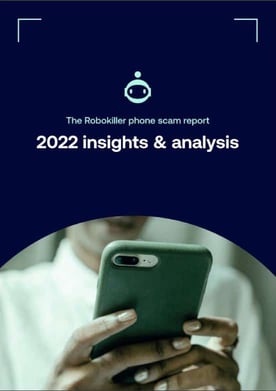
In a Nutshell: If it’s not one thing, it’s another. Although scammers sent a new high of 78 billion spam calls to US consumers in 2022, that was only an 8% increase from 2021. Meanwhile, SMS text spam exploded to 225.7 billion, a 157% increase from a then-record 87.8 billion in 2021. Robokiller blocks billions of those calls and texts so consumers don’t have to deal with them. And Robokiller’s 2022 Phone Scam Report explains the rise of SMS spam and assesses the 2023 battle against it.
It’s time mobile consumers understood what experts have predicted — SMS text spam is the topmost security and privacy threat on phones, and we consumers are behind the eight ball on dealing with it. The astronomically high number of spam calls is beginning to show signs of leveling off thanks to government action. But the surge in texting scams that Robokiller first identified in 2020 has continued to escalate and surpass spam call levels each year since.
Those are the key takeaways from Robokiller’s 2022 Phone Scam Report, the mobile security leader’s flagship annual assessment of the state of robotexts and robocalls. Robokiller’s award-winning text and spam call blocker is 99% effective at stemming the tide of unwanted calls and messages.

Robokiller has prevented more than $600 million in losses to phone scams. Hundreds of thousands of Robokiller users form a Spam Patrol community by providing feedback and identifying trending scams. Robokiller integrated historical data, economic factors, emerging patterns, and raw numbers to analyze call and text trends and create the 2022 Phone Scam Report.
Patrick Falzon, General Manager of Robokiller’s parent company, Teltech, said the team increasingly views call and text spam in separate categories on different trajectories.
“Spam texts are a much lower-friction experience,” Falzon said. “The call to action is just tapping a link, and it’s much easier for scammers to replicate legitimate SMS communications.”
That’s a recipe for exploitation amid mostly bad news for Americans. Although spam calls increased only 8% in 2021-22, they still caused an estimated $65+ billion in losses and even more distractions. On the other hand, spam texts have increased by 307% since 2020 and 157% in 2021-22.
“Americans received 225+ billion robotexts in 2022,” Falzon said. “This is the new threat that everyone needs to pay attention to.”
How Government Action Slowed Spam Call Growth
First, the good news. The 2022 Phone Scam Report shows that government action on the technology and enforcement fronts finally started reducing call spam growth after a decade of false starts.
STIR/SHAKEN is a factor — it’s a communication protocol, not a choice one makes when ordering a martini. The Federal Communications Commission (FCC) rolled out STIR/SHAKEN as a mandatory regulation for US voice service providers in 2021. It targets caller ID spoofing (a technique used by scammers to conceal their identities) and has led to more effective spam prevention technology, which Robokiller developers have certainly taken advantage of.

“What that shows us is the government attention paid to spam calls over the past few years is starting to have an impact,” Falzon said. “They’re slowing the growth, at least, which we think is a first step.”
A series of enforcement actions may carry even more impact because certain kinds of spam calls may practically disappear. For example, car warranty calls dropped from about 1 billion in June 2022 to fewer than 7 million by September because the FCC shut down the scams and held the bad actors and voice networks behind them responsible.
Student loan scams, which Robokiller measured as the fifth most common phone scam in 2021, fell by 88% in December 2022 following a public notice from the FCC that pinpointed a network responsible for allowing the calls to go through.
The FCC also removed a carrier from the Robocall Mitigation Database for failure to address robocall scams. “With the FCC in attack mode, chances are other prominent scams will plummet, and the parties responsible for sending and allowing them will be held accountable,” said Robokiller in the 2022 Phone Scam Report.
Still, continued vigilance is warranted given that the Report also cites FCC data showing the average robocall scam now costs the victim $1,500, up from $1,000 in 2021.
“This is still a very real problem that consumers have to deal with on a day-to-day basis,” Falzon said.
A Losing Battle Against Robotexts — So Far
Unfortunately, the 2022 Phone Scam Report predicts that Americans will experience a rising tide of text scammers in 2023 and the coming years. Falzon said substantive differences between the two mediums mean this new SMS tide is even more dangerous. It’s already causing more than $20 billion in annual losses.
“The biggest reason they’re more dangerous than spam calls is it’s easier to fall victim to text scams,” Falzon said. Call scammers typically ask people to take action by divulging personally identifiable information or physically transferring assets. It’s a conversation and a significantly higher-friction encounter than SMS.
Meanwhile, legitimate SMS marketing messages and calls to action have already made inroads into consumers’ everyday routines, so people are less surprised by SMS spam. And text messages are already elementary in terms of their formatting and appearance, which means they’re a walk in the park for a criminal to imitate.

“SMS marketing is popular as a legitimate marketing channel for businesses because they get very high conversion rates,” Falzon said. “It’s the same for scammers.”
When people almost reflexively click those text links, they may land on a legitimate-looking webpage where they’ll be prompted to enter information the scammer will exploit. Or the link may install malware and set up an electronic conduit.
“That really could be your Amazon driver asking about your delivery or your bank asking whether a charge is legitimate,” Falzon said. “You’re already conditioned that these things are normal.”
Robokiller Puts Consumers in Control
That sets up 2023 and beyond as years of increasing threats from SMS text spam. With calls on the cusp of extensive shutdowns, scammers are quickly spinning up text operations because the government has not focused as heavily on that.
“They’re years behind where they are in spam calls,” Falzon said. “Scammers see that too, and they’re going to take advantage of that disparity.”
That makes Robokiller’s cutting-edge features more important than ever. Its predictive call-blocking algorithm proactively analyzes incoming calls before they ring and identifies whether they’re spam in less than a millisecond.

AI-based Answer Bots embedded in Robokiller engage with scammers so they can’t bother anyone else. The app’s patented audio-fingerprinting technology creates a unique audio recording of each robocaller and checks it against a global database. Robokiller can shut down scams in real-time, even when scammers spoof their phone numbers.
Robokiller has blocked more than 1 billion scammers since its inception, with new scams always in its sights.
The 2022 Phone Scam Report predicts a 50% rise in robotexts but only a 5% increase in robocalls in 2023. The car warranty and student loan scams seem on the wane, with other well-known scam vectors likely to follow due to stepped-up enforcement. Meanwhile, regulators are paying more attention to SMS spam.
Robokiller goes public in the war against phone spam through reports like the Phone Scam Report and by continually improving its AI and machine learning algorithms through constant investment and innovation.
Vigilance is important. With generative AI now producing deep fake voices, it’s only a matter of time before new threats emerge.
“There’s this perception that phone spam is more a nuisance or annoyance than anything else, but it is very squarely a threat,” Falzon said. “We strongly believe everyone should have a spam contact blocker on their phone, and we think we’re the best on the market.”






